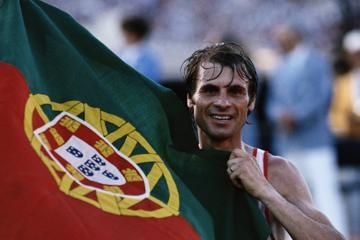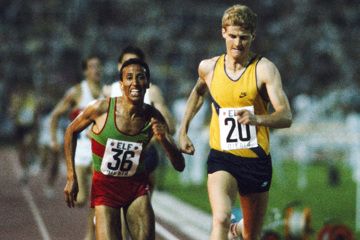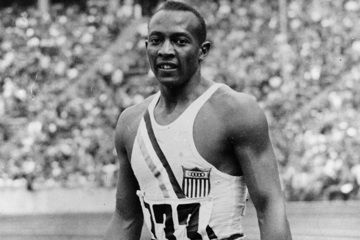Swedish middle-distance runners Gunder Hagg (left) and Arne Andersson (right)
It was 75 years ago today, on 17 July 1945, in the Swedish city of Malmö that the first sub-four minute mile was so nearly achieved. Almost nine years before that honour fell to Britain's Roger Bannister the 26 year-old Swede, Gunder Hägg, came within four strides of athletic immortality. His time was 4:01.3, rounded up to 4:01.4 for world record ratification purposes as times for the mile officially then had to be recorded to a fifth of a second.
While most of Europe was being devastated by World War II, and little athletics action was possible, in neutral Sweden the sport was thriving and drawing big crowds, principally because of the intense rivalry between Hägg and his compatriot Arne Andersson, and the growing possibility that either might achieve eternal fame by becoming the world's first sub-four minute miler.
Hägg, born on the last day of 1918 and the son of a lumberjack, took up running in 1936 aged 17 and was progressing well until in 1939 he caught pneumonia, was in hospital for most of the summer and on discharge was told by his doctor to forget about his running career. Happily, he ignored that advice and in 1940 he clocked 3:51.8 for 1500m, only three seconds slower than the Swedish record set by Andersson (born on 27 October 1917) in 1939. Amid increasing clamour by fans and the press for the pair to lock horns, the first of numerous clashes occurred in August. Neither won the 1500m race, that distinction going to Henry Kälarne, a world record breaker at 2000m and 3000m, in a national record 3:48.7 with Hägg a very close second in 3:48.8 and Andersson third in 3:51.0.
The world record at the time was Jack Lovelock's 3:47.8 when the New Zealander so memorably won the 1936 Olympic title in Berlin, but Hägg broke that with a 3:47.6 victory over Andersson (3:48.6) in August 1941. Better was to follow in July 1942. First, Hägg broke Sydney Wooderson's 1937 world mile record of 4:06.4 by 0.2, then Andersson himself ran 4:06.2 nine days later, and one week after that Hägg smashed the 1500m record with 3:45.8.
Hägg had the last word in the mile too as in September he deprived Andersson of a share in the world record by clocking 4:04.6. Oh, and "Gunder the Wonder" also found time to set world records that season at 2000m, 3000m, 2 miles, 3 miles and a barrier-breaking 5000m (13:58.2). Within the space of 82 days, Hägg competed in 26 races - winning all and setting ten world records.
In 1943, while Hägg was on a barnstorming undefeated racing tour of the USA, raising funds for the US Army Air Force Aid Society, Andersson came into his own on home soil, setting world records of 3:45.0 and 4:02.6, and it was he who brought the prospect of a four minute mile into sharp focus by lowering the record to 4:01.6 ahead of Hägg (4:02.0) in an epic race in Malmö in July 1944. Honours were even that summer as Hägg had earlier smashed the 1500m record with 3:43.0, one second ahead of his perpetual rival.
And so to 1945 and that historic mile race on Malmö's 393m Idrottsplats track before a sell-out crowd of over 14,000. The pacemaker Ake Pettersson hared around the first 440 yards in 56.2 with Hägg timed at a seemingly suicidal 56.6. Inevitably the pace of the second quarter was much slower at 61.9 for a halfway time of 1:58.5, and Hägg reached three-quarters in 2:59.7. He had company, though, for at 1500m (3:45.4) he was only three metres clear of Andersson. His rival drew level, ominously as Andersson usually had a stronger kick, but Hägg did not panic, calmly accelerating away to cross the line in 4:01.3. Andersson was second in 4:02.2 while Rune Persson clocked 4:03.8 for the fastest ever third place time.
The great duo would meet only once more, an anti-climactic affair in late September when both finished far behind a new Swedish star in Lennart Strand who in 1947 would equal Hägg's 1500m world record of 3:43.0. Indeed, they would never race again, for in November 1945 both men received life bans for professionalism in this era of strict amateurism, thus ending their chances of becoming the first four minute miler. That distinction went to Bannister in 1954 although, had he not lost what could have been his best running years as a result of the war, Sydney Wooderson might have got in first.
Wooderson raced Andersson twice in 1945 following VE Day (8 May). On the first occasion, at London's packed White City Stadium on 6 August, the sport-starved spectators (among them a 16-year-old Bannister) saw the diminutive, bespectacled 30-year-old Englishman line up against the much taller, powerfully built Swede, seemingly with no chance of giving him a good race. Andersson had run his 4:02.2 less than three weeks earlier, while Wooderson's best that season had been 4:14.8. Even that was remarkable as the previous summer he had spent nearly four months in hospital with severe rheumatism, followed by two months' convalescence, and told by doctors he could never run again.
Against all the odds, Wooderson led at the bell in 3:08.2 and Andersson won by just 0.4 in 4:08.8. Andersson's winning margin in the re-match, in Gothenburg on 9 September, again was four-tenths, only this was a much faster race. Andersson led at three-quarters in 3:02.8 to Wooderson's 3:03.0 and had to pull out all the stops to prevail after the latter led through 1500m in a British record of 3:48.4. Andersson won in 4:03.8 with Wooderson smashing his eight year-old national record with 4:04.2. That was Wooderson's last serious mile race but in 1946 he won the European 5000m title in 14:08.6, second only to Hägg's world record of 13:58.2, a remarkable achievement by a man who eight years and a world war earlier had set a world record of 1:48.4 for 800m.
Mel Watman, a long time athletics journalist and historian, is co-editor and publisher of Athletics International
Mile record evolution
Inaugural world (IAAF) record: 4:14.4 John Paul Jones (USA) 1913
First under 4:10: 4:09.2 Jules Ladoumegue (FRA) 1931
First under 4:05: 4:04.6 Gunder Hägg (SWE) 1942
First under 4:00: 3:59.4 Roger Bannister (GBR) 1954
First under 3:55: 3:54.5 Herb Elliott (AUS) 1958
First under 3:50: 3:49.4 John Walker (NZL) 1975
First under 3:45: 3:44.39 Noureddine Morceli (ALG) 1993
Current record: 3:43.13 Hicham El Guerrouj (MAR) 1999









